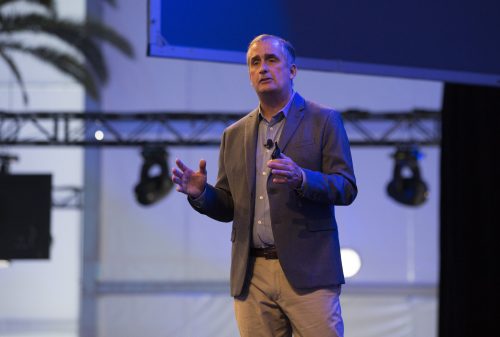Intel's CEO, Brian Krzanich: Each autonomous vehicle will generate about 4,000 GB - or 4 terabytes - of data every day; Data is the "oil" that will drive the future of autonomous transportation

The CEO of Intel, Brian Krzanich, announced tonight (Wed) that Intel Capital, the chip giant's investment arm, will invest 250 million dollars in the next two years to develop an autonomous car. Krzanich said these things at the opening of the Los Angeles Auto Show.
It was the first time that Intel participated in the Los Angeles show, one of the most important car shows in the world. At Intel, which has recently been undergoing a dramatic change with a greater emphasis on the development of big-data and connectivity technologies, they see great importance in connecting the company to the global automotive industry.
Kraznich said that the automotive industry is currently on the brink of a major change, which will include unprecedented demands for computing, data and connectivity, and the investments will focus on innovative and ground-breaking technologies in these areas and other areas such as artificial intelligence, machine learning, cyber, safety and more.
"The world today is driven by oil. Try to drive today's car without petroleum-based products - and you probably won't get very far. It can be said that the products based on the use of petroleum distillates are the key technology that shape the automotive world we know today. But all that is about to change. When it comes to the car of the future and automated driving experiences, data is the new "oil". Just as oil changed our world in the last hundred years, data is the factor that is expected to change our world for the next hundred years - and beyond.
"I think that we currently live in a world that is flooded with data, but the amount of data that we generate today is very small compared to the future. In 2016, the average person generates 650 MB of data per day through the use of computers, mobile phones, wearable computing products and more. Forecasts show that in 2020 the average person will generate 1.5 GB of data per day. This is an impressive 200 percent increase in less than four years. But that figure pales in comparison to what we're about to see in autonomous vehicles.
"In an autonomous car we need cameras, radar, sonar, GPS and LIDAR - just like today we need pistons and pipes. Cameras will produce between 20 and 60 MB per second; Radar will produce at least 10 km per second; Sonar - 10 to 100 kb per second; GPS - about 50 kbps and LIDAR between 10 and 70 Mbps. Therefore, each autonomous vehicle will generate about 4,000 GB - or 4 terabytes - of data every day. Each autonomous car will generate the data equivalent of nearly 3,000 people. Considering the number of cars on the road, if it is estimated that there are a million cars in the world - this means that automatic driving will generate data for 3 billion people.
"But it's not enough just to collect data; We need to turn data into insights to get its full value. To do this, an end-to-end computing solution is needed - from the car through the network to the cloud - and strong connectivity. When it comes to the future of transportation, Intel's commitment to its partners, to the industry and to the world is to lead change in the world of computing, to provide new solutions and to accelerate the field of autonomous driving", Kraznich said.
More on:
BMW and Intel will join the Israeli Mobilya in developing an open platform for autonomous cars
Who is responsible when the steering wheel is in the car's hands?
An autonomous truck inspired by nature
Intel unveiled the new communication system it developed for Stephen Hawking

2 תגובות
Intel a little carried away took on the car computer
And it has not yet been found safer than human practice